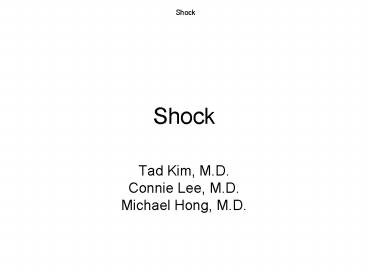Shock - PowerPoint PPT Presentation
1 / 24
Title:
Shock
Description:
... Tx: fluids, tx underlying cause (relieve PTX, pericardiocentesis, change ventilator settings) Neurogenic Shock Shock 2/2 spinal cord injury, ... – PowerPoint PPT presentation
Number of Views:112
Avg rating:3.0/5.0
Title: Shock
1
Shock
- Tad Kim, M.D.
- Connie Lee, M.D.
- Michael Hong, M.D.
2
Shock Definitions
- Shock inadequate tissue perfusion
- Tissue perfusion is determined by
- Cardiac output (CO) HR x SV
- SV function of preload, afterload,
contractility - Systemic vascular resistance (SVR)
3
Shock Types
- Hypovolemic
- Septic (high CO, low SVRI)
- Cardiogenic (high CVP)
- Neurogenic
- Anaphylactic
- Adrenal insufficiency
4
Shock Types Physiology
Shock CVP/PCWP CO SVRI
Hemorrhagic ? ? ?
Septic either ? ?
Cardiogenic ? ? ?
Neurogenic ? ? ?
Hypoadrenal either ? ?
Anaphylactic ? ? ?
5
Hypovolemic Shock
- CNS response to hypovolemia
- Rapid peripheral vasoconstriction, increased
cardiac activity - Sustained arterial vasoconstriction, Na/water
retention, increased cortisol - 2/2 hemorrhage or fluid loss
- Classes of hemorrhage
- I 15
- II 30 tachycardia
- III 40 decreased SBP, confusion
- IV gt40 lethargy, no UOP
- Tx stop source / fluids / blood
6
Septic Shock
- SIRS T gt38C or lt36C, HR gt90, RR gt20, PaCO2
lt32mmHg, WBC gt12 or lt4 - Sepsis SIRS focus of infection
- Severe sepsis sepsis MSOF
- Septic shock sepsis refractory hypotension
- Remember septic shock is a/w high CO
- Tx fluids, antibiotics
7
Cardiogenic Shock
- Cardiogenic shock 2/2 cardiac disease or cardiac
compression - Cardiac disease MI, arrhythmia, valve
dysfunction, increased PVR or SVR, increased
ventricular resistance - Cardiac compression tension PTX, cardiac
tamponade, positive pressure ventilation - Look for Becks triad in tamponade (hypotension,
JVD, muffled heart sounds) - Tx fluids, tx underlying cause (relieve PTX,
pericardiocentesis, change ventilator settings)
8
Neurogenic Shock
- Shock 2/2 spinal cord injury, regional
anesthesia, autonomic blockade - Mechanism loss of vasomotor control, expansion
of venous capacitance bed - Signs warm skin, normal or low HR, normal CO,
low SVR - Tx Fluids / pressors / - steroids
9
Hypoadrenal
- Unresponsive to fluids or pressors
- Tx steroids
10
Shock Signs
- Pale, cool skin
- Change in MS, lethargy
- Decreased UOP
- Hypotension, tachycardia, tachypnea
11
Shock Evaluation
- Airway includes brief evaluation of mental
status - Breathing
- Circulation includes placement of adequate IV
access - Disability identification of gross neurologic
injury - Exposure ensures complete exam
- History OPQRST, review PMHx, PSHx, ALL, SHx
- PE complete
- Labs include ABG (pH, base deficit, lactate)
12
Case 1
- 55y M post-op day 0 s/p colectomy
- Called for tachycardia, hypotension, altered
mental status, abdominal distension, decreased
UOP - PE pale, disoriented, abdomen tense, TTP,
w/rebound tenderness, UOP 15mL/hr - What is your diagnosis?
- What additional information should you obtain?
- What is the plan?
13
Case 1 Continued
- Dx hemorrhagic shock
- Additional information CBC, coags, TC
- Management
- ABC (intubate, IV access)
- Resuscitate (isotonic IVF)
- Prepare for take-back
14
Case 2
- 75y M h/o CAD, PVD, DM, POD 1 s/p AAA repair c/o
nausea - What do you need to think about?
- What is the plan?
15
Case 2 Continued
- Dx MI
- Plan
- ABC
- MONA, beta-blockade
- Cardiology consult for catheterization
- Labs/x-rays cardiac enzymes Q8H x3 sets w/EKG,
chemstick, BMP, CXR/KUB
16
Case 2 Continued
- Cath w/critical stenosis of left main s/p balloon
angioplasty - PE intubated, 80/50, UOP 10mL/hr
- Echo severe LV dysfunction
- What is the diagnosis?
- What is the plan?
17
Case 2 Continued
- Dx Post-myocardial infarction (cardiogenic)
shock - Plan
- ABC
- Pressor support as needed
- Placement of Swan-Ganz catheter
- /- Intra-aortic balloon pump, cardiac assist
device - Heparin (maintain coronary patency)
18
Case 3
- 60y M h/o chronic ETOH use presents to ED w/ N/V
and epigastric pain radiating to the back - PE tachycardic, hypotensive, confused
- What is the working diagnosis?
- What is the plan?
19
Case 3 Continued
- Dx Hypovolemic shock 2/2 acute pancreatitis
- Plan
- ABC (intubate, IV acess, NGT, Foley, DHT)
- Resuscitate
- Labs chemstick, ABG, BMP, LFT, amylase/lipase,
CBC, coags - Studies CXR, CT A/P
20
Case 4
- 55y M POD 0 s/p colectomy, w/epidural placed for
post-op pain control - Called by nurse for hypotension and bradycardia
- PE AAOx3, abdomen ND, NT
- Recent post-op labs HCT 35
- What is your working diagnosis?
21
Case 4 Continued
- DX Neurogenic shock 2/2 epidural
- Treatment is
- IVF
- Turn down or turn off epidural
- If BP does not respond to IVF, initiate pressor
support w/alpha-agonist such as phenylephrine
22
Case 5
- 25y M p/w diffuse abdominal pain. PMHx PUD.
- PE febrile, tachycardic, hypotensive, lethargic,
rigid abdomen w/ involuntary guarding - What is your working diagnosis?
- What is your plan?
23
Case 5
- Dx septic shock 2/2 duodenal perforation
- Plan
- ABC
- Broad-spectrum IV antibiotics
- Emergent OR for ex-lap, washout repair
24
Shock Take Home Points
- Shock inadequate tissue perfusion
- Types of shock hypovolemic, septic, cardiogenic,
neurogenic, anaphylactic - Signs of shock altered MS, tachycardia,
hypotension, tachypnea, low UOP - Always start with ABCs
- Resuscitation begins with fluid (exception -
cardiogenic shock)































